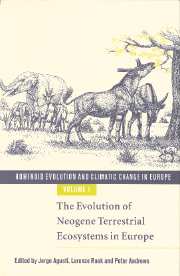Book contents
- Frontmatter
- Contents
- List of contributors
- Acknowledgements: The European Science Foundation
- 1 Introduction
- PART I Palaeogeography of the circum-Mediterranean region
- PART II Miocene mammalian successions
- 5 A critical re-evaluation of the Miocene mammal units in Western Europe: dispersal events and problems of correlation
- 6 Large mammals from the Vallesian of Spain
- 7 Trends in rodent assemblages from the Aragonian (early–middle Miocene) of the Calatayud-Daroca Basin, Aragon, Spain
- 8 The Late Miocene small mammal succession from France, with emphasis on the Rhône Valley localities
- 9 Late Miocene mammals from Central Europe
- 10 An overview on the Italian Miocene land mammal faunas
- 11 The Miocene large mammal succession in Greece
- 12 Chronology and mammal faunas of the Miocene Sinap Formation, Turkey
- 13 The Late Miocene small mammal succession in Ukraine
- PART III Palaeoenvironments: non-mammalian evidence
- PART IV Palaeoenvironments: mammalian evidence
- Index
11 - The Miocene large mammal succession in Greece
from PART II - Miocene mammalian successions
Published online by Cambridge University Press: 15 December 2009
- Frontmatter
- Contents
- List of contributors
- Acknowledgements: The European Science Foundation
- 1 Introduction
- PART I Palaeogeography of the circum-Mediterranean region
- PART II Miocene mammalian successions
- 5 A critical re-evaluation of the Miocene mammal units in Western Europe: dispersal events and problems of correlation
- 6 Large mammals from the Vallesian of Spain
- 7 Trends in rodent assemblages from the Aragonian (early–middle Miocene) of the Calatayud-Daroca Basin, Aragon, Spain
- 8 The Late Miocene small mammal succession from France, with emphasis on the Rhône Valley localities
- 9 Late Miocene mammals from Central Europe
- 10 An overview on the Italian Miocene land mammal faunas
- 11 The Miocene large mammal succession in Greece
- 12 Chronology and mammal faunas of the Miocene Sinap Formation, Turkey
- 13 The Late Miocene small mammal succession in Ukraine
- PART III Palaeoenvironments: non-mammalian evidence
- PART IV Palaeoenvironments: mammalian evidence
- Index
Summary
Introduction
The Miocene Greek large fossil mammal localities are not documented for the beginning of the Miocene (MN 1 and MN 2). The MN 3 zone could be represented by the locality Kalimeriani but this locality could also be dated to MN 4. This latter zone is represented by Aliveri and the limit MN 4–MN 5 by Antonios. The biozone MN 5 is well known through the localities of Thymiana (island of Chios) with small and large mammals. A sole locality (Chrysavgi) has been found from MN 6 to MN 8. The late Miocene (MN 9 to MN 13) is very well known with several localities. The two ages of mammals, Vallesian and Turolian, have clearly different faunas. Actually new excavations seem to be necessary for a better knowledge of early and middle Miocene faunas and to describe more precisely the biostratigraphy of the late Miocene.
Some Miocene Greek fossil large mammal localities (continental Greece and Aegean archipelago) have been known for the past century but others have been found recently. They cover a large part of the Miocene but those of the latest Miocene (Turolian) are more abundant and better known. The fossils coming from these localities allow quite good dating of the Greek continental deposits. The aim of the present article is to classify the large fossil mammal localities in a chronological order using the available biochronological data as well as other processes of dating. Faunal lists of these localities are given together with some other information. The Greek Miocene series of fossil mammal localities is incomplete. The biozones MN 1, MN 2, MN 6 and maybe MN 3 have never been found in Greece.
- Type
- Chapter
- Information
- Hominoid Evolution and Climatic Change in Europe , pp. 205 - 237Publisher: Cambridge University PressPrint publication year: 1999
- 18
- Cited by



